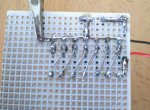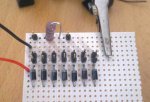bobhaha
0
- Joined
- May 31, 2009
- Messages
- 3,239
- Points
- 63
@edy
The resistor is a 1 ohm load. With a 1 ohm load, we can directly convert voltage to current.
Using Ohms law...
V= IR
Since we know the resistance is 1ohm, we can re write the equation like this...
V=Ix1
Or
V=I
Where V is voltage and I is current.
So when measuring a voltage across the resistor, you are effectively measuring the current in the system.
-Adrian
The resistor is a 1 ohm load. With a 1 ohm load, we can directly convert voltage to current.
Using Ohms law...
V= IR
Since we know the resistance is 1ohm, we can re write the equation like this...
V=Ix1
Or
V=I
Where V is voltage and I is current.
So when measuring a voltage across the resistor, you are effectively measuring the current in the system.
-Adrian






